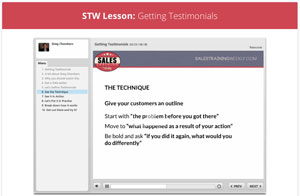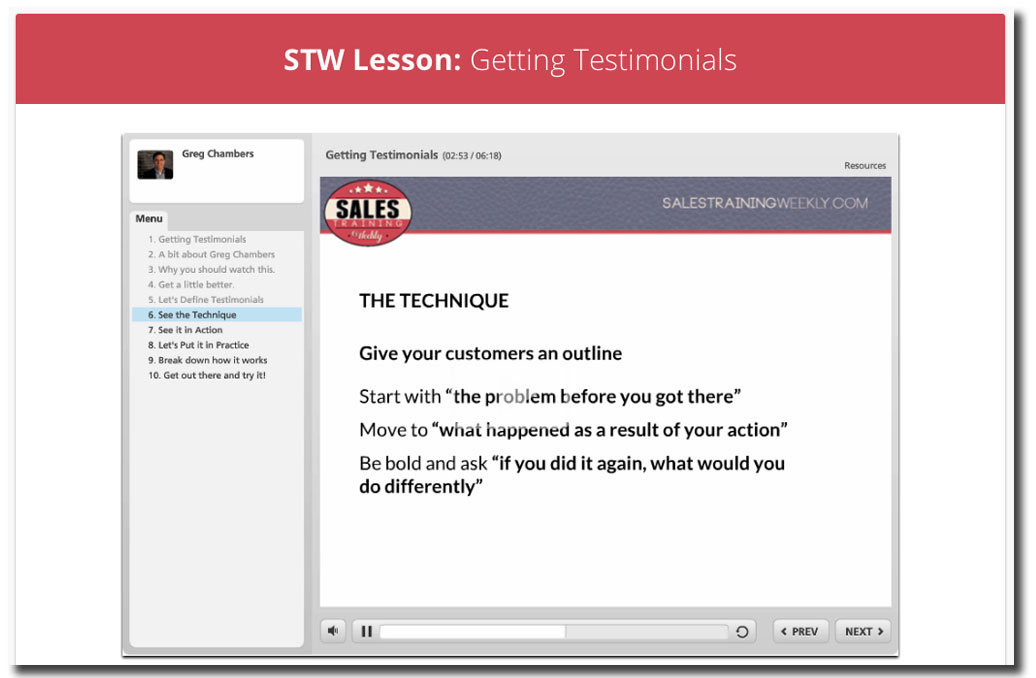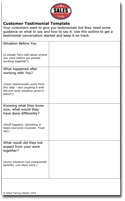Your Very Own Customer Testimonial Template
Your Very Own Customer Testimonial Template
One of the most powerful tools in your business development toolbox is Testimonials. Why are testimonials so powerful? Let’s summarize a concept from Dr. Robert Cialdini the author of Influence: The Psychology of Persuasion: People will do things that they see other people are doing. A testimonial helps because it lets prospects see that other people are already “doing it” or are “willing to do it”.
Great, you say, so how do I get more testimonials?
Simple, just follow this template that I recorded for my Sales Training Weekly project:
(clicking on the link will send you to the Sales Training Weekly website. The lesson is free of charge.)
If you’re not interested in watching the video, here is the transcript.
[expand title=”Transcript”]
Hello and welcome to another addition of Sales Training Weekly.
This one is Getting Testimonials, or, “I don’t believe a word you say, and only half of what that guy says, but 100 percent of what I say.” Let me start by identifying myself. I’m Greg Chambers. I’m one of the sales trainers here at Sales Training Weekly, and I’m gonna be walking you through this quick little tool on how to get some testimonials. I can help you convince your customer that you are gonna be able to do what you say you can do. So, let’s start where it’s important. I kind of covered a little in the segue– or the little sidebar at the beginning there.
People don’t necessarily – believe it or not, people don’t necessarily believe what you say. Now, they do want to know how you can help. And, ultimately what you say is not going to be as critical as what you’ve done. The goal here always is to control your language so you can control the conversation. And, in this way, we’re gonna give you some tools to control the conversation to get some testimonials. The reason we’re doing this ultimately is because ewe just want to get a little bit better at it. Right? We want to move ourselves up to that mastery level. Preschool chairs are small for a reason. If we’re not great at it today, we’ll get better at it. Maybe someday you’re the one giving the lessons here at Sales Training Weekly.
Let’s start by defining because that is the beginning of all wisdom, right? A testimonial is gonna be – we all know what a testimonial is. Right? But, I’m gonna stick with this definition. A statement testifying to a person or business’s qualifications.
So, if I say it, it’s not necessarily believed. But, if a customer says it, you’re prospect is more likely to take what they have at value. The trick is you actually need some customers in order for this to work. But, we can kind of work around that down the road. But, this lesson is going to assume that you actually have at least one customer, or that the business you work for has at least a customer.
Okay, let’s jump into the technique. Let’s jump into the language that we can use to control this. You want to give your customers an outline in order for them to fill it out. It’s just a lot easier to communicate. Right?
So, let’s start with this first part of getting a testimonial. What was the problem before you got there? And, when I say you, that’s me. So, if I were helping somebody, I’d want to know, “Hey, Jim, before I got here, what was the problem that you were facing again?” This is to get them to restate the way things were because I’ve been working with Jim for some time.
And, then I want to ask Jim, “So, what happened as a result of you taking action, the action being working with me?” And, then I’m even going to go a step further and I’m going to ask, “If you did it again, what would you do differently?”I’m not living in some fantasy world that everything has been perfect between me and Jim since the day we started working together. But, chances are we’ve both grown.
And, inside of that little nugget there’s things that can help me, but there’s also a lot of things that can help another customer going forward.
And, then I’m going to end with, “And, what unexpected results came from your action?” I generally know what these are, or have a good idea because I’ll use them in future sales presentations. I want Jim to point out, “This was what I was trying to solve. This is what I solved. This is some things I do differently. And, you know what? Here’s some other things that happened inside of my company that I didn’t necessarily expect to happen, but I’m happy it happened. And, I’m gonna help attribute some of that.”
Okay, so let’s see it in action as far as how we get into this conversation, now that we have kind of an outline that we’re going to follow. It’s not kind of an outline. It’s a great outline.
Let’s see what are some ways that you can get into this. Sometimes it’s easier just to see the way not to do it. If you go into somebody and say, “Hey, can I get a testimonial?” it’s too broad. They would say, “Yeah, I’d love to give you a testimonial.” And, I learned this myself. People say, “Oh, yeah.” But, they never got any testimonials back to me. It’s too broad.
Better was, “If I sent you this outline would you fill it out and send it back?” Because, at the very least it’s like a MadLib or something. It’s just fill in the blanks and get it going. But, the best way is to ask them, “Do you have a few minutes? Because, I want to ask you a few questions about your experience with us, and at the end I’m gonna tie it up and say, “Is it all right if I use this as a testimonial?”
Okay, let’s look at one of these and see what they look like in practice. So, I called up one of my customers. I walked him through this and then summarized it. And, this is what I ended up sending back to him. So, you can see, before I started working with Greg Chambers we didn’t have visibility into our sales pipeline, which made it tough to plan staffing and cash flow. He helped out staff rethink our digital strategy, and we’re generating more sales. I only with we would have brought Greg in sooner.” So, this is an actual testimonial that I give to my clients when they’re considering me. Let’s break this down a little.
Okay, so looking at the information, the first thing is we started with, “What was the problem before I got there – before I started working with Greg Chambers?” You can see that. And, then we worked into, “What happened as a result of the action? If they did it again, what would they do differently?” That ends up being, “Bring Greg in sooner.” So, it ended up being a good one for me. And, that’s where I got it. So, phone call to client. I transcribed it. I sent it back for approval. I had to explain how it would be used, because of course, he was very interested in, “Well, what is this going to be used for?” And, then it’s part of that intro first meeting packet. So, it isn’t something that’s out there publically and then I include his name, title, and phone number, and information so that my prospects can follow up with him. But, you can see where the outline, coupled with a good question on the front end, helped me control the conversation and get a testimonial I can use for the future.
Once again, don’t expect to be perfect at this the first time out, but do try it. Start with, at the very least, the better is have an outline, send it over to them, and ask them to fill it out. And, then get more comfortable when you’re with your super most comfortable person or an old customer. Walk through that outline with them verbally. I think you’ll find that testimonials will be coming your way.
[/expand]
Here’s a link to the Customer Testimonial Template too. Enjoy.
Good stuff.
About the Author: Greg Chambers is Chambers Pivot Industries. Get more business development ideas from Greg on Twitter.



